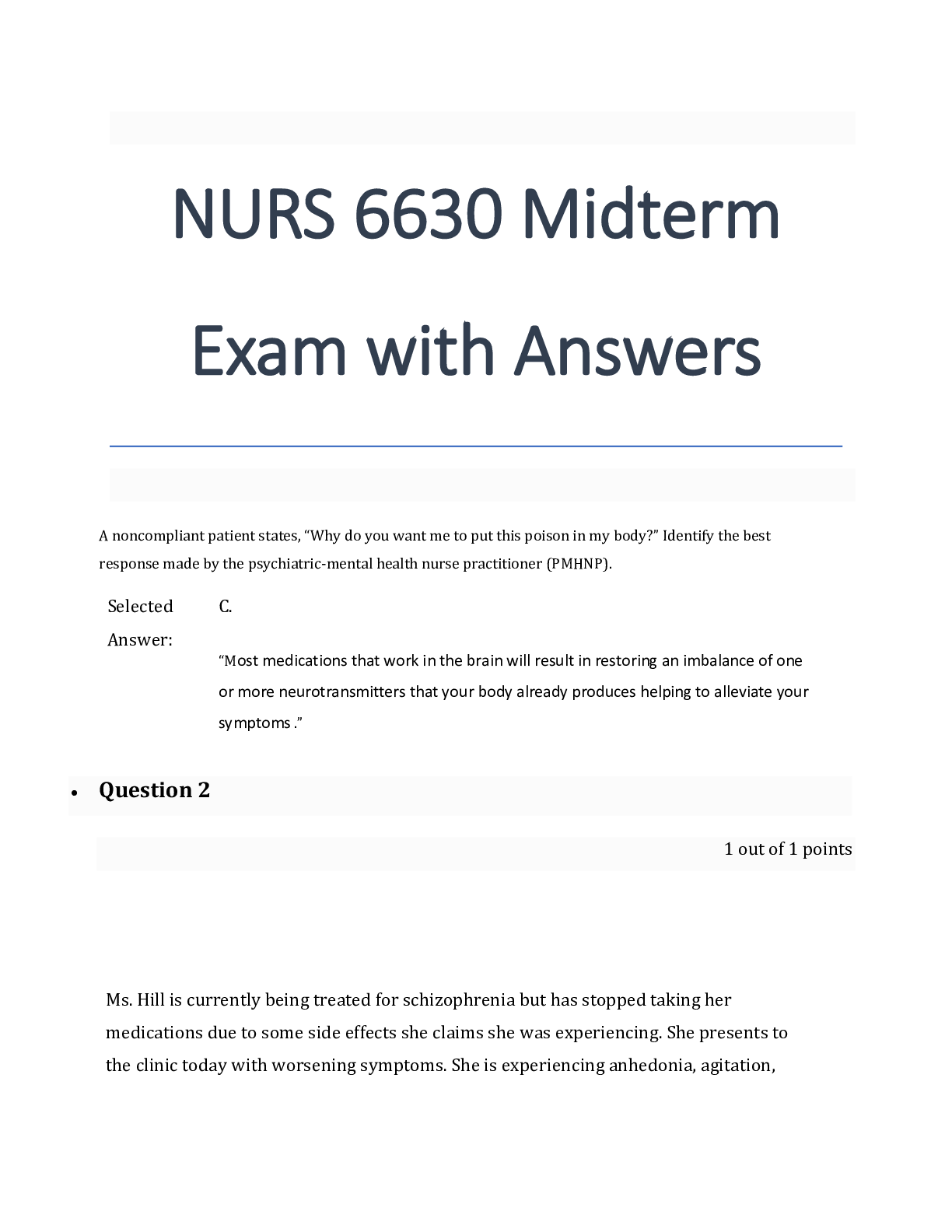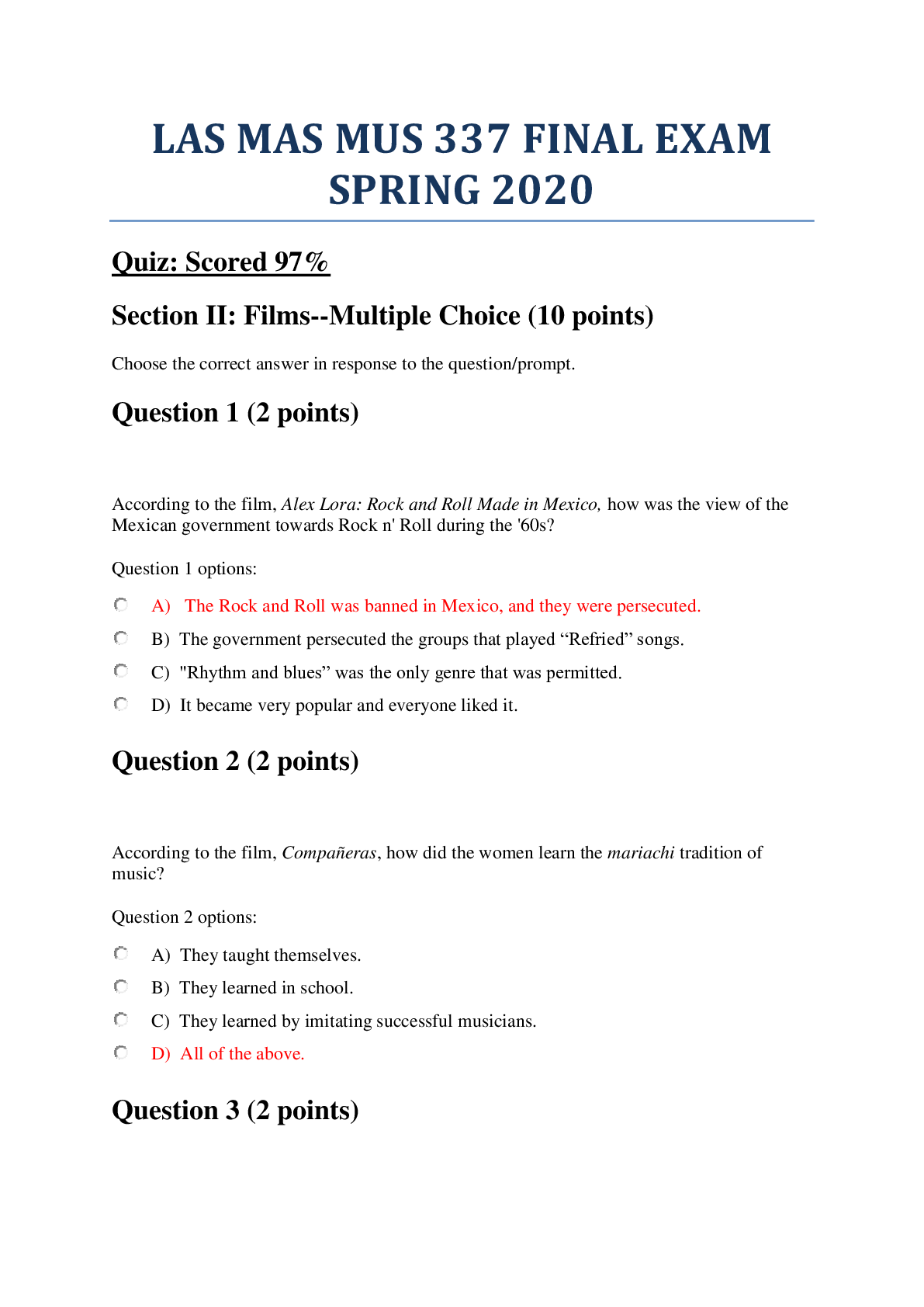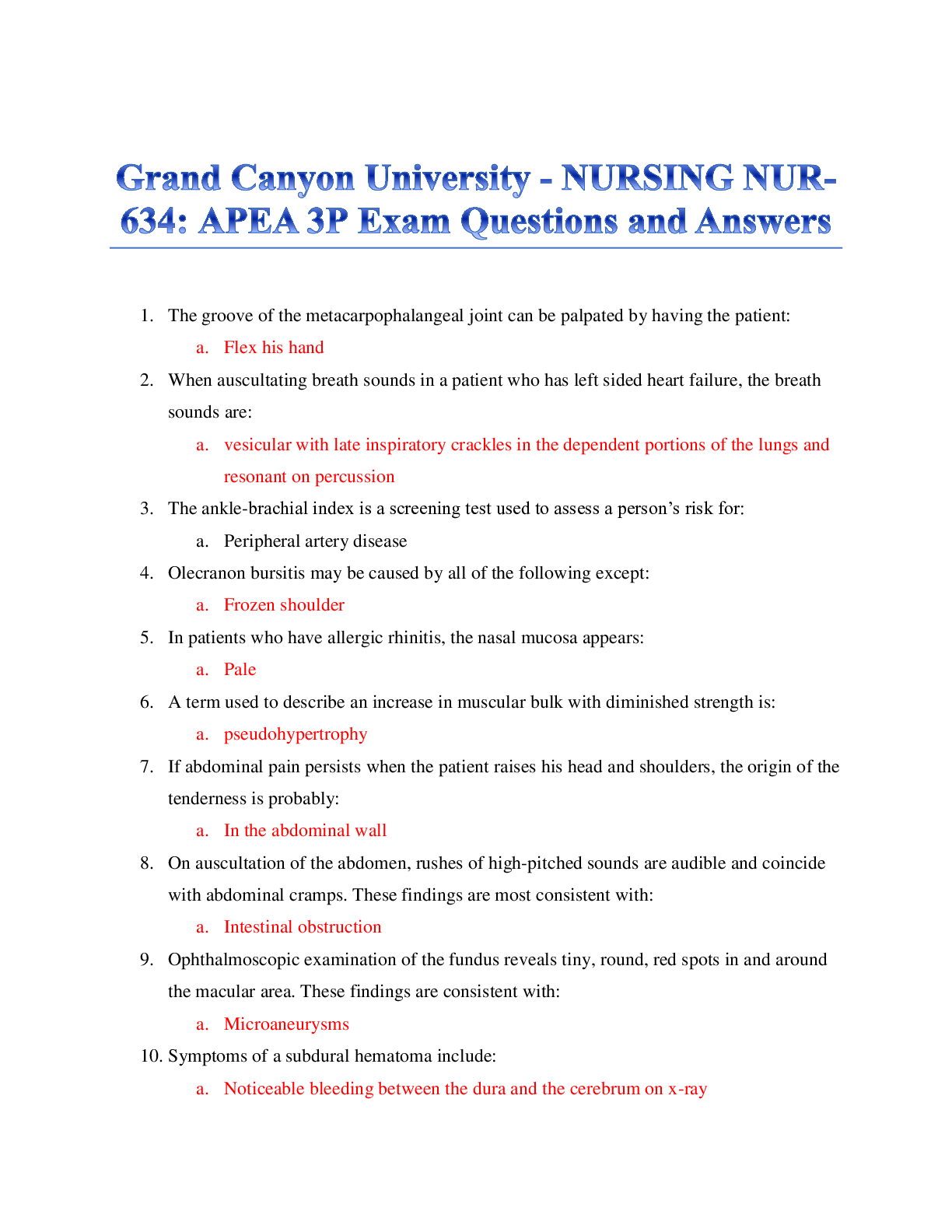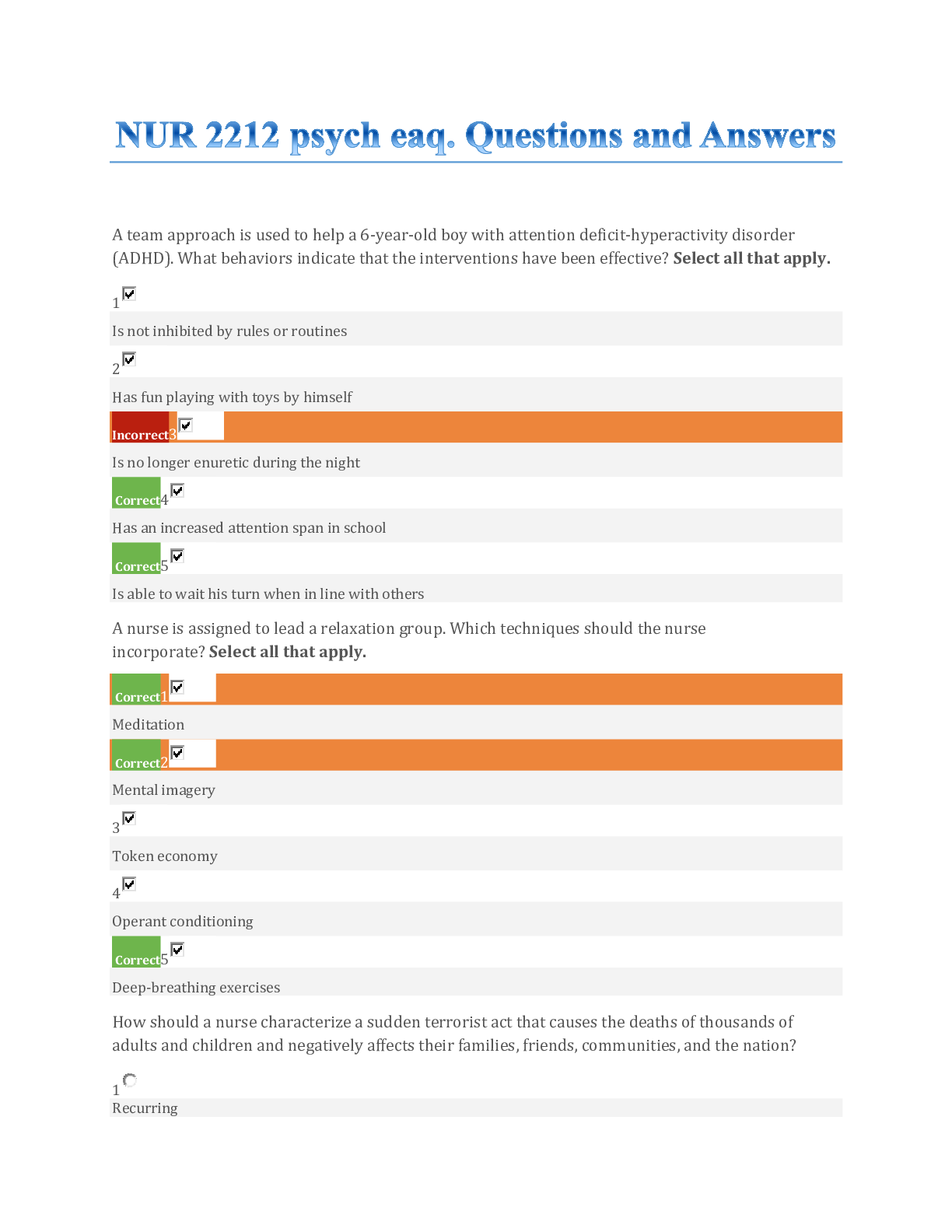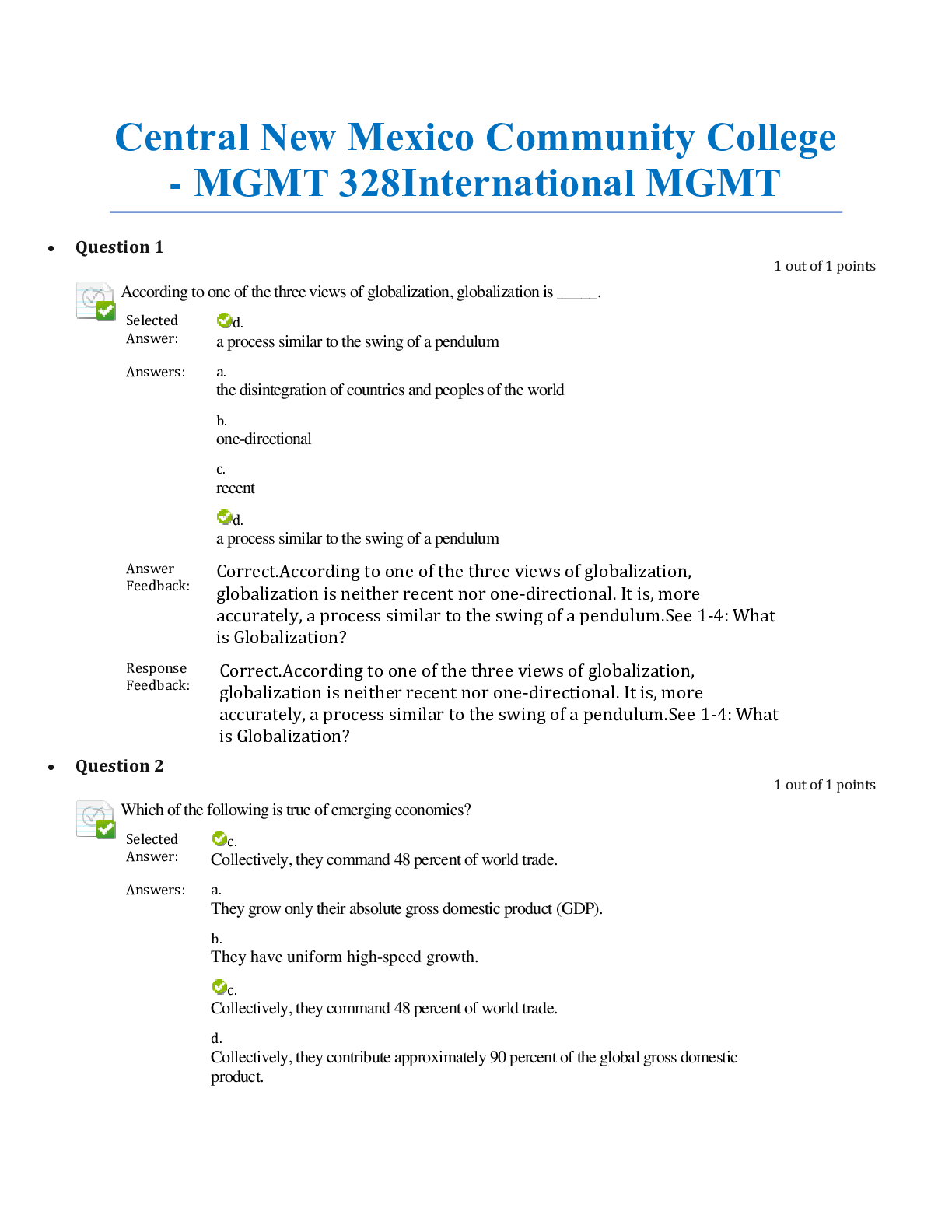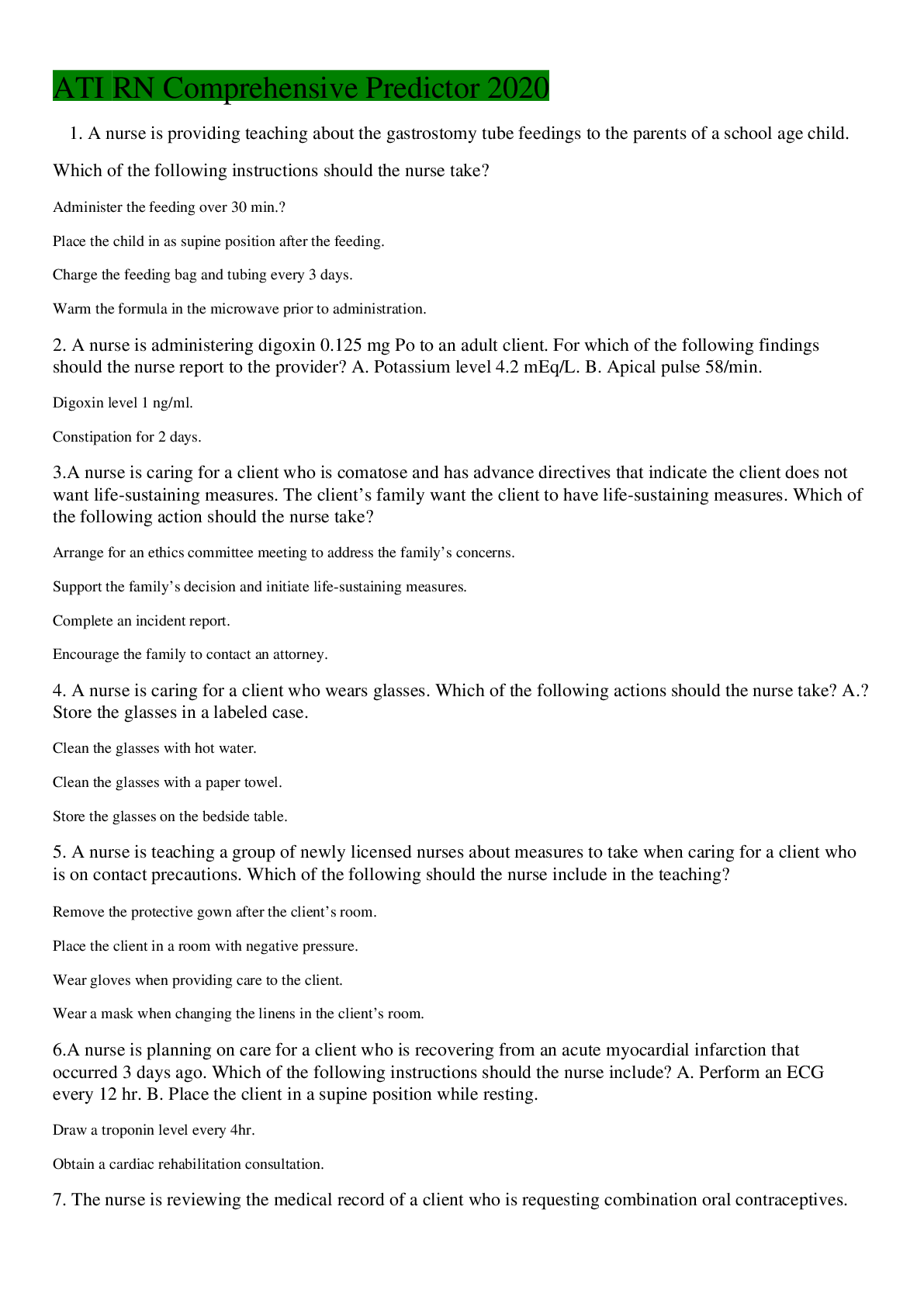Management > EXAM > Central New Mexico Community College - MGMT 328 Midterm Exam. Scored and Graded A (All)
Central New Mexico Community College - MGMT 328 Midterm Exam. Scored and Graded A
Document Content and Description Below
Question 1: explain the issued discussed about globalization as defined in the Harvard video from week 1 (Getting Global Strategy Right (Pankaj Ghemawat)) QUESTION 2 1. Turning over an organization... al activity to an outside supplier that will perform it on behalf of the local firm is also called: a. Captive sourcing b. Inshoring c. Offshoring d. Outsourcing 3 points QUESTION 3 1. The point at which an industry-specific activity becomes common across industries and the need to keep it proprietary no longer exists is also called: a. Commoditization b. Specification c. Break even point d. Pinnacle 3 points QUESTION 4 1. A chain of activities used in the production of goods and services that add value is a(n): a. Value chain b. Vertical chain c. Activity chain d. None of these answers 3 points QUESTION 5 1. Turning over an organizational activity to a domestic firm is also called: a. Captive sourcing b. Inshoring c. Offshoring d. Outsourcing 3 points QUESTION 6 1. The difficulty of identifying the causal determinants of successful firm performance is also called: a. Causal identification b. Ambiguity c. Performance indicator d. Causal ambiguity 3 points QUESTION 7 1. Which of the following is NOT a tangible asset? a. Financial resources and capabilities b. Physical resources and capabilities c. Human resources and capabilities d. Technological resources and capabilities 3 points QUESTION 8 1. The view in global business which deals with external opportunity threats is also called: a. Global-business external view b. Resource-based view c. Institution-based view d. Global-business internal view 3 points QUESTION 9 1. Which of the following set of clusters includes ALL countries? a. GLOBE b. Hofstede c. Ronen and Shenkar d. Huntington 3 points QUESTION 10 1. You as a student studying this book are advised to invest in your career by doing the following except: a. Learn at a minimum two foreign languages b. Spend one semester globally c. Make international friends d. Be aware of the prevailing norms and global transitions QUESTION 11 1. ____ is an individual's ability to understand and adjust to new cultures. a. Cultural intelligence b. Cultural awareness c. Cultural skills d. Cultural responsibility 3 points QUESTION 12 1. Which of the following is NOT an influential set of clusters outlined in the text? a. GLOBE b. Hofstede c. Ronen and Shenkar d. Huntington 3 points QUESTION 13 1. Which of the following is the law enacted in 1977 that bans bribery to foreign officials? a. Trust Against Bribery and Distortion Act b. Foreign Corrupt Practices Act c. Statute of Limitation on Foreign Direct Investment Act d. Bribery of Foreign Public Officials Act 3 points QUESTION 14 1. The greatest weakness in the fight against eradicating corruption is: a. There is too much corruption to ever win. b. Every country must institutionalize and enforce anti-corruption laws. c. The fact that the Foreign Corrupt Practices Act is no longer being followed. d. Overseas bribes are often tax deductible. 3 points QUESTION 15 1. Which of the following is a factor behind English being accepted as the global business language? a. English speakers have traditionally been more mobile than non-English speakers. b. It is easiest to translate to and from English. c. English-speaking countries contribute the largest share of global output. d. English is the number one language in the world. Question 16: struggle between socialism and capitalism in the 20th century: QUESTION 17 1. Which of the following definitions best defines an expatriate manager? a. A manager who works outside his or her native country b. A manager of great expertise c. An ex-manager rehired for advisory purposes d. None of these answers 3 points QUESTION 18 1. The ____-based view suggests that the formal and informal rules of the game, known as institutions, shed a great deal of light on what is behind firm performance around the globe. a. Resource b. Asset c. Capability d. Institution 3 points QUESTION 19 1. What defines the field of global business more than anything else? a. The focus on firm performance around the globe b. The focus on ROI of the global venture c. The focus on maximizing profits while minimizing expenses d. The focus on global expansion 3 points QUESTION 20 1. According to the text, most MNEs are ____ the base of the pyramid. a. Focusing on b. Ignoring c. Aware of countless opportunities of d. Considering FDI in the economies at 3 points QUESTION 21 WRONG 1. Why study global business? a. In order to increase one's employability b. In order not to get Bangalored or Shanghaied c. In order to better understand how to become a sought-after, globe-trotting manager d. All of these answers 3 points QUESTION 22 1. The global economy can be viewed as a pyramid. The Triad represents: a. US, Germany, England b. US, Western Europe, China c. Brazil, India, China d. North America, Western Europe, Japan QUESTION 23 WRONG 1. Which of the following is NOT a reason why global business should be studied? a. Because many ambitious students aspire to join the top ranks of large firms. b. To acquire hands-on global experience in global business. c. Because many top rank managers are selected from the pool of expatriate managers d. In order for one's earning potential to be maximized. Question 24: compare or contrast one of the issues discussed in one of the current event articles from the semester to one of the Commanding Heights videos. . Week 2: How India got its funk The funk referred to in the title of the article was the downturn in India’s market when it should have been sailing high. Inflation and lack of economic reforms were the major players in the funk. One surprising fact is “only 3% of Indians pay income tax”. How does the government operate when a small fraction of the population doesn’t contribute to the overall health? Debt keeps piling up for India and exports are not growing. Car and motorcycle sales have slumped. The article also references that private companies are simply not brining business into the country as they were previously. Which came as a surprise to me because it seems every other day I read about another company opening a branch in India. The real estate market would be a natural sector to rise up if more companies brought business into the country. It appears that their government needs to take a look at international policies QUESTION 25 WRONG 1. Which of the following is most focused on currency diversification? a. Currency hedging b. Spot transactions c. Strategic hedging d. Trading risk 3 points QUESTION 26 1. Why was the US dollar chosen as the currency to which other currencies would be pegged? a. The US had high levels of productivity. b. The US was experiencing a large trade surplus. c. The US contributed approximately 70% of the global GDP. d. All of these answers 3 points QUESTION 27 1. Which is NOT one of the primary types of foreign exchange transactions? a. Swaps b. Direct transactions c. Spot transactions d. Forward transactions 3 points QUESTION 28 1. Which of the following is NOT one of the components of the balance of payments? a. Currency trade b. Merchandise trade c. Service trade d. Capital movement 3 points QUESTION 29 1. A country experiencing a current account surplus will see its currency ____, while a country experiencing a current account deficit will see its currency ____. Appreciate, appreciate Appreciate, depreciate Depreciate, appreciate Depreciate, depreciate 3 points QUESTION 30 1. If central bankers raise interest rates to curb inflation, they risk driving currency ____. If their interventions in the foreign exchange market drive the currency ____, they may boost inflation. a. Up, up b. Up, down c. Down, down d. Down, up QUESTION 31 1. Which of the following is best defined by "the conversion of one currency into another at Time 1, with an agreement to revert it back to the original currency at a specific Time 2 in the future"? a. Currency swap b. Direct currency transaction c. Spot currency transaction d. Forward currency transaction 3 points QUESTION 32 1. The ____ is defined as the difference between the offered price and the bid price. a. Offer rate b. Spread c. Discount d. Premium 3 points QUESTION 33 1. Non-MNE firms can also do business abroad by: a. Licensing and franchising b. Outsourcing and engaging in FPI c. Exporting and importing d. All of these answers 3 points QUESTION 34 1. When entering foreign markets, basic entry choices include: a. Exporting and importing b. Exporting and FDI c. Exporting and licensing d. Exporting, licensing, and FDI 3 points QUESTION 35 1. ____ suggests that FDI, unrestricted by government intervention, will enable countries to tap into their absolute or comparative advantage by specializing in the production of certain goods or services. a. The radical view b. The free market view c. Pragmatic nationalism d. Expropriation QUESTION 36 1. MNEs' possession and leveraging of certain valuable, rare, hard-to-imitate, and organizationally embedded (VRIO) assets overseas in the context of FDI refer to: a. Location advantage b. Ownership advantage c. Internalization d. Market imperfections 3 points QUESTION 37 1. Firms prefer FDI to licensing because: a. FDI reduces dissemination risks. b. FDI provides tight control over foreign operations. c. Certain know-how is difficult to convey without FDI. d. All of these answers 3 points QUESTION 38 1. A type of FDI in which firms move upstream or downstream in different value chain stages in a host county is identified as: a. horizontal FDI b. radical FDI c. vertical FDI d. FDI flow 3 points QUESTION 39 1. Knowledge that can be written down and transferred without losing much of its richness is known as: a. Explicit b. Implicit c. Valid d. Legible 3 points QUESTION 40 1. ____ are restrictions on the quantity of goods brought into a country. a. Export restraints b. Import quotas c. Local content requirements d. Antidumping duties QUESTION 41 1. As a major tariff barrier, a(n) ____ is a tax imposed on imports. a. Import tariff b. Export tariff c. Deadweight costs d. NTBs QUESTION 42 1. The birth of modern economics and the forerunner of the free trade movement are strengths and influences of: a. Absolute advantage b. Comparative advantage c. National competitive advantage d. Mercantilism points QUESTION 43 1. Although American movies dominate the world market, ____ limit the market share of American movies to protect their domestic movies. a. Canada b. France c. South Korea d. All of these answers 3 points QUESTION 44 1. NTBs include: a. Subsidies, import quotas b. Export restraints, local content requirements c. Administrative policies, antidumping duties d. All of these answers 3 points QUESTION 45 1. A policy to assist strategic advantage is known as: a. Strategic trade policy b. "Diamond" policy c. Heckscher-Ohlin policy d. Free trade policy QUESTION 46 1. Political arguments against free trade include: a. National security and consumer perception b. Foreign policy and environmental and social responsibility c. Foreign policy and national security d. National security, consumer perception, foreign policy, and environmental and social responsibility QUESTION 47 1. A pure command economy is: Characterized by the "invisible hand" of market forces. Defined by a government taking the "commanding height" in the economy. Characterized by a government that only performs functions the private sector cannot perform. Characterized by innovation and entrepreneurial activities. 3 points QUESTION 48 1. ____ are exclusive legal rights of firms to use specific names, brands, and designs to differentiate their products from others. a. Patents b. Trademarks c. Copyrights d. Intellectual property rights 3 points QUESTION 49 1. More than 80 countries practice: a. Common law b. Civil law c. Theocratic law d. Social democracy 3 points QUESTION 50 1. Jewish and Islamic law are examples of: a. Common law b. Theocratic law c. Civil law d. Quasi-democracy 3 points QUESTION 51 1. Civil law is derived from: a. Greek law b. Roman law c. Latin law d. None of these answers 3 points QUESTION 52 1. The government taking a "hands-off approach" is known as: a. Laissez faire b. Command economy c. Mixed economy d. Liberal approach 3 points QUESTION 53 1. An institutional framework is made up of: a. Regulatory and cognitive pillars b. Formal and informal institutions c. The political, economic, and legal systems of countries d. None of these answers [Show More]
Last updated: 2 years ago
Preview 1 out of 15 pages

Buy this document to get the full access instantly
Instant Download Access after purchase
Buy NowInstant download
We Accept:

Reviews( 0 )
$9.00
Can't find what you want? Try our AI powered Search
Document information
Connected school, study & course
About the document
Uploaded On
May 23, 2020
Number of pages
15
Written in
Additional information
This document has been written for:
Uploaded
May 23, 2020
Downloads
0
Views
129

